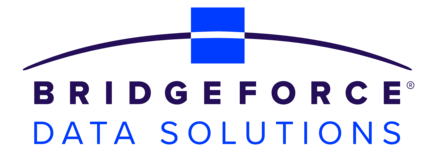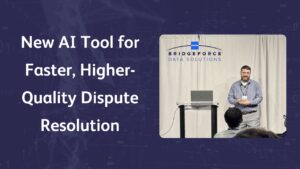Update 12/16: Check out Matt’s latest update here – Bridgeforce Data Solutions CEO Corner Q4 2024
CEO Corner Q3 2024
2024 has been a busy year for us, reflecting a combination of our internal initiatives and the changes we are seeing in the technology and regulatory space around us. Our pace of learning has increased so much that I’m reminded of being a student and my first time leading a company (during the internet boom of the late 90’s).
I therefore thought it might be helpful to start sharing some reflections, starting with this blog and continuing with quarterly ones in the future. I hope you find this valuable, and I would appreciate any feedback you have.
Key Trends
For this first blog, we’ll hit three topics: the CFPB, Gen AI, and insights we see in the data from indirect disputes.
The CFPB Evolving how it Evaluates Consumer Reporting Data
The CFPB has significantly increased the rigor of how it evaluates consumer reporting files. We have been consistently hearing in recent months about CFPB requests for Metro 2® data files (going back many months) as part of their exams. Then, in on-stage discussions at the CDIA Connect event in May, Erin Jeweler (Deputy Assistant Director in the CFPB) said that they are looking at Metro 2® data and making sure that furnishers are too.
The subsequent discussion seemed to me to confirm that the CFPB has more robust tools for evaluating the files than in the past, increasing the pressure on furnishers to conduct comprehensive evaluations themselves. This, combined with their recent enforcement actions and tone, certainly increases the pressure on furnishers to detect any issues in their furnishing data and get them fixed.
Generative AI
We’ve been hearing the hype about AI for a long time. I remember Deep Blue beating Garry Kasparov in 1997, right as I was finishing grad school, and at the time there were plenty of predictions about the speed with which AI was going to change things. I’ve therefore stayed relatively skeptical for a long time, but then last year that changed for me.
I started digging deeper into AI than I had in years, and I believe that by using retrieval-augmented generation (RAG), we can securely combine the power of our IP with the most cost-effective LLMs for specific use cases. This year we began developing AI tools that will help Dispute Agents investigate disputes, I’ve had the pleasure in recent weeks of seeing great progress with our prototypes, and I look forward to sharing more information in my next blog post about what we are learning in the process.
Data Quality Scanner Disputes Module Insights
Upon release of the new Data Quality Scanner Disputes Module in January, we started working with clients to analyze their indirect dispute data and compare it to the Metro 2® files that are being reported.
From what I have seen, these are brand new insights that paint a more nuanced picture of the data involved in disputes. For starters, a few key points:
Data issues in indirect disputes are more prevalent than I expected.
- I was surprised by how many borrowers are disputing information on the account vs. ownership of the account.
- There are large numbers of disputes in which the trade line involved is showing data in the dispute request that does not meet the data quality rules that we would expect (i.e., not conforming to Metro 2® guidelines).
These data issues often create ambiguity, and therefore cost and risk.
- In most cases the disputing borrower still appears to be responsible for the debt, and the data issue present does not change that, but there are still data issues present.
- In these cases, different CRAs and agents may all handle these disputes in different ways.
- At minimum, these data issues hurt the credibility of the furnisher, CRA, or both, in the eyes of regulators and consumers. In many cases, the data issues appear to invite the dispute in the first place.
The consistency with which disputes agents address the data issues we see varies widely.
- For example, even in an organization that is fixing a strong majority of the data issues we detect, we may see individual agents ranging from 40% to 98%.
- The issues are typically clustered around specific scenarios, and therefore can be addressed through a combination of policy changes and training.
- Agents are typically creating new data issues 10-15% of the time.
The data issues we see are mostly from a mix of furnishing, CRA changes, and responses to prior disputes.
- Seeing the end-to-end view of the chain of events is very helpful for understanding root cause.
- There are differences in the data handling practices across the CRAs, so it is valuable for furnishers to understand what is happening with the data they furnish. With our DQS Disputes module, furnishers are seeing this comprehensively for their indirect disputes for the first time, and it is highly valuable in helping them to meet regulatory expectations of ensuring maximum possible accuracy for the data they furnish.
Overall, the prevalence of data issues and inconsistencies in disputes, when compared to the Metro 2® file furnished and the ACDV data, shows that this is an area worthy of much greater attention, and I am excited to get more granular with the data to further support this.
How Bridgeforce Data Solutions is Adapting to These Trends
All in all, these findings do not change what Bridgeforce Data Solutions is doing as a company, but further confirm the need for comprehensive data reviews and ongoing vigilance in updating our product. Just this year, we released two updates: a standard rule update at the beginning of the year, and another comprehensive update with the release of new updates to the CRRG.
We continue to dig deeper into the data for clients to find insights and make them available in the most easily digestible way. We strive to provide our clients with actionable results so that changes and updates can be made. We are proud to see our mature clients continue to lower their discrepancy rates by 80-90% as well as reduce their dispute rates by 30%.
Lastly, as we work to implement new AI tools into our products, we are thankful for AWS’s continued support, as they provide us with the tools and SME-support necessary to work through our use cases. We look forward to utilizing Amazon Bedrock as a core feature in our development cycle moving forward.
I want to thank our customers and partners for their continued support as we strive to provide a first-class product to those in the industry.



